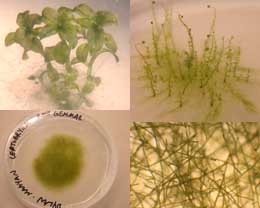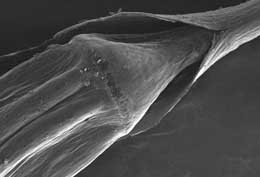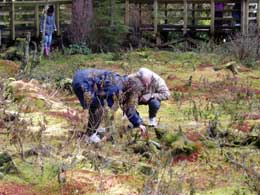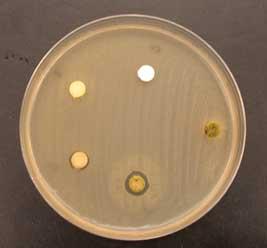Course Description:
 Lab and lecture complement each other. There are usually between 30 and 38 students registered (although this year I am restricting enrolment to 25). We meet for three hours twice a week. At each meeting there is a one-hour lecture followed by a two-hour lab. Lecture is where introductions to the main groups are made as well as ecological and evolutionary relationships discussed. Images and demonstration materials are incorporated for preview and review. We do not use clickers per se, but multiple questions are posed and students respond by holding up either with fingers or numbered, coloured cards. In lab, students have the opportunity to investigate the organisms and learn how to identify them. There is a tissue culture project for which the students collect data over the course of the term. There are fieldtrips offered every other week to ensure students connect what is being learned in the lab and lecture with the “real” world. Students are required to submit a 15-specimen collection by the end of the term as well as do a large project which they present to the rest of the class and submit a term paper.
Lab and lecture complement each other. There are usually between 30 and 38 students registered (although this year I am restricting enrolment to 25). We meet for three hours twice a week. At each meeting there is a one-hour lecture followed by a two-hour lab. Lecture is where introductions to the main groups are made as well as ecological and evolutionary relationships discussed. Images and demonstration materials are incorporated for preview and review. We do not use clickers per se, but multiple questions are posed and students respond by holding up either with fingers or numbered, coloured cards. In lab, students have the opportunity to investigate the organisms and learn how to identify them. There is a tissue culture project for which the students collect data over the course of the term. There are fieldtrips offered every other week to ensure students connect what is being learned in the lab and lecture with the “real” world. Students are required to submit a 15-specimen collection by the end of the term as well as do a large project which they present to the rest of the class and submit a term paper.
Course Information and Artifacts:
 Fieldtrip Handout – Example
Fieldtrip Handout – Example
Lab Exam – Part I – This was a station type exam (5 stations, 12 minutes each) – key
Midterm Lecture Exam Outline
List of Bryophytes Required to Know – Students are required to know about 50 common bryophyte species.
Lab Exam Preparation
Collection Marking Scheme
Reading Help Guide
Bryophyte Collection – Each student is required to submit a collection of 15 bryophtyes (identified to species and properly documented).
Keys for local species of Polytrichids and Sphagnum were developed.
Study questions are developed by students for each unit.
Course Website:
 Vista Site
Vista Site
We participated in the e-portfolio pilot for UBC. See reflections on teaching. It has become the hub of the course where students get access to all discussions, hand-outs, etc.
 Public Site
Public Site
When I first taught the course I asked the students what type of website they felt would be best for the course they said they wanted to share the bryophytes with the world (that WebCT was restrictive because it required a password). The public site was generated as a student (and class) project in 2000. Since then it has been added to every year. The image archive is linked to from the course website. Links to public site.
Duties:
 I am responsible for the entire course (lab, lecture, website, and fieldtrips). I developed the course from scratch, but am fortunate that Dr. Wilf Schofield’s office was just down the hall. He was always willing to teach a guest lecture and provide valuable advice and expertise. He enjoyed coming into the lab and helping studens. We enjoyed going on bryological excursions together (Vancouver Island, Queen Charlotte Islands, Lower Mainland).
I am responsible for the entire course (lab, lecture, website, and fieldtrips). I developed the course from scratch, but am fortunate that Dr. Wilf Schofield’s office was just down the hall. He was always willing to teach a guest lecture and provide valuable advice and expertise. He enjoyed coming into the lab and helping studens. We enjoyed going on bryological excursions together (Vancouver Island, Queen Charlotte Islands, Lower Mainland).
Lab/Course Materials:
 To provide material for their lab exercises, extensive collection is required. I collect from various places including Cypress Mountain, Stanley Park, UBCFarm Agroforestry Trail, and City of Vancouver. The UBC Herbarium also provides materials for class demonstration and prepared slides are incorporated.
To provide material for their lab exercises, extensive collection is required. I collect from various places including Cypress Mountain, Stanley Park, UBCFarm Agroforestry Trail, and City of Vancouver. The UBC Herbarium also provides materials for class demonstration and prepared slides are incorporated.
Teaching Goals:
 The bryophytes are overlooked by many. In Biology 321 I try to give the students an idea of where these organisms fit into the world. We discuss their relationships with each other and with other plants. We examine what is currently known about them, what questions have yet to be answered, and areas of research. This is a course where fieldtrips are very important. Specimens are presented during lab, but having plants in bins does not compare to seeing them in their natural habitats. By the end of the course I want the students to be able to identify by sight, 50 of the common bryophytes that grow in our region. As with my other lab courses I think the experience with microscopy is invaluable and the skills of observation cannot be understated. Students are offered an optional session to do Scanning Electron Microscopy in the UBC BioImaging Facility.
The bryophytes are overlooked by many. In Biology 321 I try to give the students an idea of where these organisms fit into the world. We discuss their relationships with each other and with other plants. We examine what is currently known about them, what questions have yet to be answered, and areas of research. This is a course where fieldtrips are very important. Specimens are presented during lab, but having plants in bins does not compare to seeing them in their natural habitats. By the end of the course I want the students to be able to identify by sight, 50 of the common bryophytes that grow in our region. As with my other lab courses I think the experience with microscopy is invaluable and the skills of observation cannot be understated. Students are offered an optional session to do Scanning Electron Microscopy in the UBC BioImaging Facility.
Class Activities
 In the first week of class the students are taught how to do semi-sterile techniques and culture a selection of different types of propagules. Over the course of the term these cultures are examined to demonstrate bryophyte development. Each lab period one or two cultures are presented to demonstrate features specific to that lab exercise (called the “culture du jour”).
In the first week of class the students are taught how to do semi-sterile techniques and culture a selection of different types of propagules. Over the course of the term these cultures are examined to demonstrate bryophyte development. Each lab period one or two cultures are presented to demonstrate features specific to that lab exercise (called the “culture du jour”).
 Because of students’ interest I added an SEM (Scanning Electron Microscopy) component to the course. Some students incorporated their images into their projects, others contributed to the course website.
Because of students’ interest I added an SEM (Scanning Electron Microscopy) component to the course. Some students incorporated their images into their projects, others contributed to the course website.
 There are two class field projects. We survey Sphagnum and other bryophytes in Camosun in collaboration with the Camosun Bog Restoration Group.
There are two class field projects. We survey Sphagnum and other bryophytes in Camosun in collaboration with the Camosun Bog Restoration Group.
 We also do a vegetation survey at UBC Farm (Agroforestry Trail). Students are required to do a project and presentation (oral or poster). They may work in groups, but each student is required to submit an individual paper. There is generally a wide range of topics. Projects include ecological studies and library research. Some students wish to pursue a study in development using tissue culture. Others collaborate with the community. (Two students developed a pamphlet called the “Bryophytes of Stanley Park” in cooperation with the Ecological Society of Stanley Park. It is currently being sold at the Nature House.) Others have done similar projects in Camosun Bog, Pacific spirit Park, UBC Botanical Garden, and Nitobe Gardens. In the latter cases the students’ presentations were class fieldtrips to these sites. Field tnps are an important component of Biology 321. There are three mandatory fieldtrips (to Pacific Spirit Park, Burns Bog, and Lynn Canyon) and a number of optional ones throughout the term (usually sites are selected based on student interest or project topic). As part of their course requirement students submit a collection of 15 bryophytes which must be presented as voucher specimens for herbarium.
We also do a vegetation survey at UBC Farm (Agroforestry Trail). Students are required to do a project and presentation (oral or poster). They may work in groups, but each student is required to submit an individual paper. There is generally a wide range of topics. Projects include ecological studies and library research. Some students wish to pursue a study in development using tissue culture. Others collaborate with the community. (Two students developed a pamphlet called the “Bryophytes of Stanley Park” in cooperation with the Ecological Society of Stanley Park. It is currently being sold at the Nature House.) Others have done similar projects in Camosun Bog, Pacific spirit Park, UBC Botanical Garden, and Nitobe Gardens. In the latter cases the students’ presentations were class fieldtrips to these sites. Field tnps are an important component of Biology 321. There are three mandatory fieldtrips (to Pacific Spirit Park, Burns Bog, and Lynn Canyon) and a number of optional ones throughout the term (usually sites are selected based on student interest or project topic). As part of their course requirement students submit a collection of 15 bryophytes which must be presented as voucher specimens for herbarium.
Bryophyte Bioassay Project:
 This year we screened a number of bryophytes for activity against three bacteria. The specemens which exhibited activity were primarily liverworts, but the Sphagnums tested also exhibited antibactierail activity.
This year we screened a number of bryophytes for activity against three bacteria. The specemens which exhibited activity were primarily liverworts, but the Sphagnums tested also exhibited antibactierail activity.
In this disk diffusion assay, filter paper disks were impregnated with plant extract and then placed on a lawn of bacteria which was grown up for 24 hours. Antibacterial activitiy is evident by a clearing zone around the filter paper disk (compoenets of the extract diffuse into the agar). The Petri dish to the left shows a number of inactive extracts. The extract of Lunularia cruciata (disk at bottom) demonstrated antibacterial activity against Bacillus subtilis.
Lynn Canyon Fieldtrip
 Another rainy day! We reviewed the bryophytes that that we have learned so far in the class We planned to run three transects but due to bad weather conditions……we only did one.
Another rainy day! We reviewed the bryophytes that that we have learned so far in the class We planned to run three transects but due to bad weather conditions……we only did one.
Course Reflections
 In lecture this year I used a review article (Shaw and Renzaglia, 2004) as a framework to discuss the evolutionary relationships of the bryophytes. I broke the paper down into components and assigned readings. Students had different experiences so it was important to provide them with explanatory information (posted on the web). Some students became lost in lecture because they had not done the readings. This year I plan to include a short assignment with the readings to ensure everyone is prepared.
In lecture this year I used a review article (Shaw and Renzaglia, 2004) as a framework to discuss the evolutionary relationships of the bryophytes. I broke the paper down into components and assigned readings. Students had different experiences so it was important to provide them with explanatory information (posted on the web). Some students became lost in lecture because they had not done the readings. This year I plan to include a short assignment with the readings to ensure everyone is prepared.
The e-portfolio project went well. This year I made less technological demands on the students and was more flexible about how they used the group aspect of the site. They were given individual and groups portfolios (presentation areas). They participated well in the group aspect of the website, but showed little interest in working on their independent presentation areas. The group work that resulted was mostly to do with group assignments and projects (tissue culture project), but a number of groups generated various forms of study guides that they shared with the rest of the class. The e-portfolio/website contributed to generating a community-based learning environment.
Student generated study questions and information processing pages proved valuable to students. The study questions were submitted to a discussion board and the students recognized their value and started to submit preliminary answers with their questions. A few students found the frequency of these assignments overwhelming (midterm evaluation and verbal feedback). I reduced the number by combining units and then explained to them that the information processing sheets should not take hours to do, but they should plan on spending a half hour to an hour. I will continue to use this format, but I think they will have an option so they have to do fewer information processing questions.
